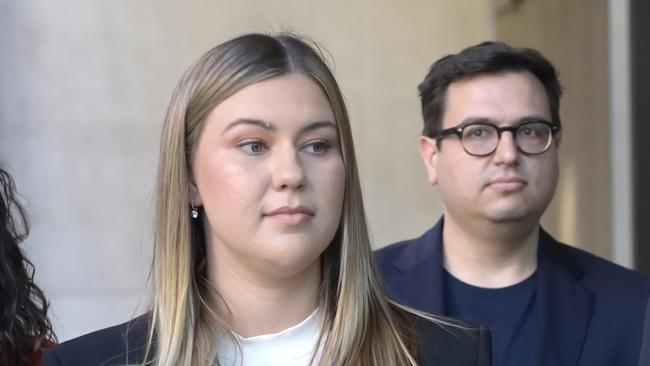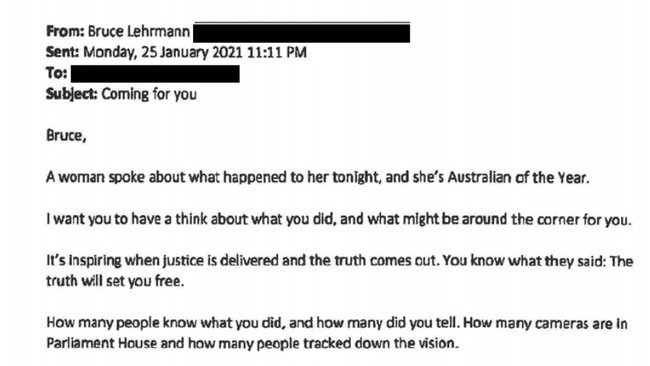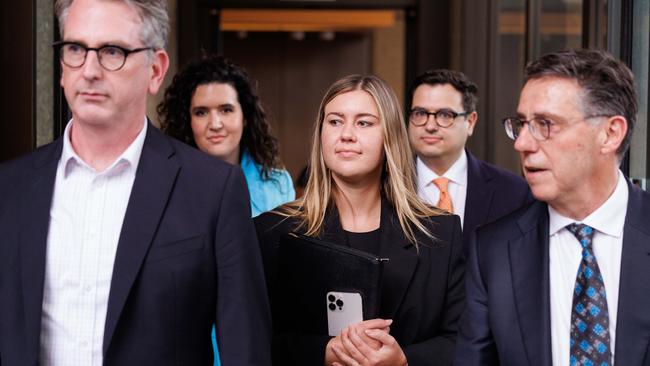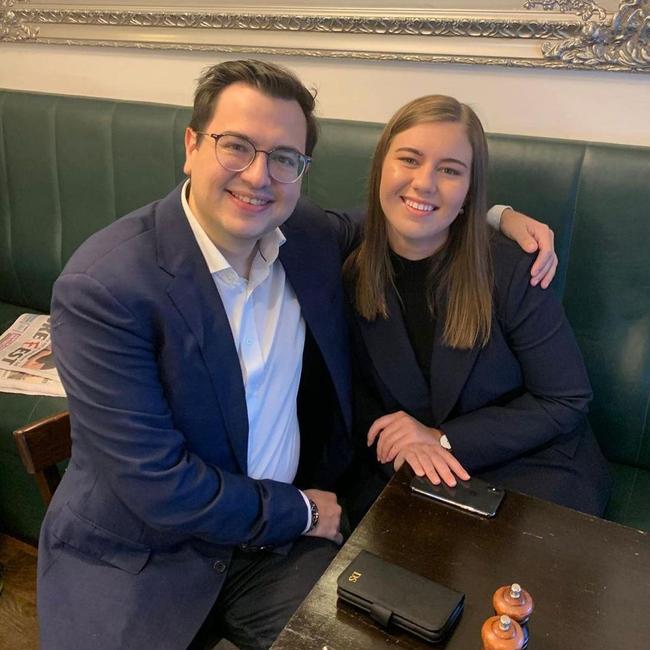Lehrmann trial judgment: David Sharaz’s key role in Project interview with Brittany Higgins
Despite not saying a word during Bruce Lehrmann’s defamation trial, Brittany Higgins’ fiance is referenced more than 100 times in the bombshell judgment.
The man who acted as a “conduit” between Brittany Higgins and the media ahead of her explosive interview with The Project was motivated by a desire to inflict “immediate political damage” on the government, a court has found.
Despite never taking the stand as a witness or authoring any submission to the court, Ms Higgins’ finance, David Sharaz, was referenced 111 times when Justice Michael Lee found in the Federal Court on Monday that Ms Higgins was raped by Bruce Lehrmann in Parliament House in March 2019.
Mr Lehrmann had launched defamation proceedings against Network Ten and journalist Lisa Wilkinson for its airing of an interview with Ms Higgins in which she made the rape allegation, arguing it was incorrect and he was identifiable.
In delivering his judgment on Monday, Justice Lee found Mr Sharaz held responsibility for “pitching” the interview to Ms Wilkinson.
He sent Ms Wilkinson an email on January 18, 2021 titled “Me Too, Liberal Party, Project Pitch”.
“Hi Lisa, I hope you’re well,” Mr Sharaz began the email.

“I’ve got a sensitive story surrounding a sexual assault at Parliament House; a woman who was pressured by the Liberal Party and female cabinet minister not to pursue it.
“She’s asked me to be the one to get the story told this year.”
He went on to explain that he was organising for his partner to do one television and one print interview to “limit the pressure on her, and the stress of telling the story too many times”.
He went on to laud Ms Wilkinson’s work on family violence topics and her “journalistic integrity and sensitivity around such issues”.
He signed off: “Much love, David Sharaz.”
During the trial, Ms Wilkinson denied that at that time she considered Mr Sharaz to be a “good friend”.
Asked by Justice Lee, during her evidence, if the salutation was “odd”, Ms Wilkinson said: “Yeah, I hadn’t had contact with him.”
Mr Sharaz became the “conduit for communication” between Ms Higgins and the media outlets he had selected to tell her story, and before broadcast, Justice Lee found, had shared Mr Lehrmann’s name with other journalists.
In a follow up email, Mr Sharaz told Ms Wilkinson: “Thank you for your time over the phone today, and your sensitivity around what I truly feel is an injustice.
“I’m sending this on behalf of Britt, purely because, and this sounds paranoid, we just don’t know who might be keeping a close eye on her.”
He also discussed why Higgins needed to be out of Canberra when the story broke.
“Brittany really needs to be out of the Parliament House when both the story breaks, and the police report is relaunched,’’ Mr Sharaz said.


Mr Sharaz was also present in a pre-interview meeting with Ms Higgins, Ms Wilkinson and a Project producer when he talked about his desire for the story to be broadcast and published to coincide with Question Time.
“So sitting week, story comes out, they have to answer questions at Question Time, it’s a mess for them,” Mr Sharaz said during the meeting at a Sydney hotel.
“March, Senate estimates. Hopefully we can try and get the footage, that sort of stuff, for Britt’s clarity, and then he’s going to call an election in whenever he calls it.”
Justice Lee said Network Ten and Ms Wilkinson had been “wilfully blind” to Mr Sharaz’s motivations.
“In the light of what had been communicated by Mr Sharaz before and during this first interview, any journalist who did not think Mr Sharaz had a motivation to inflict immediate political damage would have to be wilfully blind,” he said in his 374-page judgment.
“Of course, Mr Sharaz was perfectly entitled to work with the Opposition and to use any truthful allegations as to what happened to damage the Government. And the mere fact he had such a motive does not mean what is being said by his girlfriend was anything other than true.
“But it is important context, and a journalist acting reasonably would recognise this motivation and scrutinise what was being conveyed cognisant of it.”
Justice Lee wrote that it was “unusual” for Mr Sharaz to be the main point of contact, but found Ms Higgins was not “acting under the Svengali-like influence” of her partner and that her wishes for the story did align with his.
“Although reasonable minds might differ, Mr Llewellyn genuinely thought it was appropriate to use Mr Sharaz as a conduit in order to communicate with Ms Higgins,” he wrote.
“It also became apparent that Ms Higgins was quite content for Mr Sharaz to be the primary point of contact and she shared Mr Sharaz’s views about the culpability and shortcomings of various politicians and they both very much wanted to hold them to account.”

Despite the court hearing that Mr Sharaz was a conduit between Ms Higgins and Ten producer Angus Llewellyn, he was never called as a witness.
“You’re not calling him?” Justice Lee asked.
However, Ten’s barrister, Dr Matt Collins contended: “He was not on the scene in 2019.”
At one point in the pre-interview meeting with Ms Wilkinson and Mr Llewellyn, Mr Sharaz said he was speaking for Ms Higgins when he said he wanted Mr Lehrmann to “forever” have difficulties in getting a job.
Justice Lee said Mr Sharaz had disclosed Mr Lehrmann’s name to members of the media before The Project interview was broadcast.
The court heard during the trial that Mr Lehrmann believed that Mr Sharaz had sent him an anonymous email in January 2021 with the threatening title “Coming for you”.
“I want you to have a think about what you did, and what might be around the corner for you,” the email said.
“It’s inspiring when justice is delivered and the truth comes out.”
During his evidence, Mr Lehrmann was asked by his barrister Steve Whybrow whether he had formed a view about the source of the email.
“I have a view that that was Ms Higgins’s fiance, Mr David Sharaz,” Mr Lehrmann told the court.
In his judgment, Justice Lee found that Mr Llewellyn and Ms Wilkinson were “willing” to help in the political weaponising of Ms Higgins’ allegation.
“The motivations of Mr Sharaz in selecting the journalists to tell and use the story were manifest and rather than this motive being a cause of some degree of circumspection, but Mr Llewellyn and Ms Wilkinson indicated their willingness to assist in the political use of the allegations as Ms Higgins and Mr Sharaz intended,” he said.



